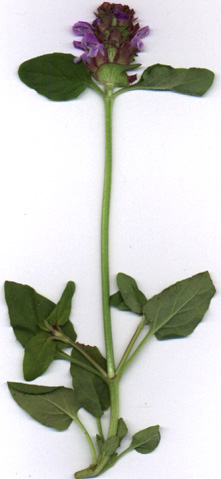
|
| Heal All; Prunella vulgaris L. |
Mint Family; LABIATÆ (LAMIACEÆ)
|
| Heal All has a most self-assured name. Numerous other plant names suggest a supposed efficacy in treating some malady or
another, for example: knitbone, goutweed, scurvey grass, feverfew, pleurisy root, nerve root, and toothache tree. But who needs these
other herbs if Heal All lives up to its name? It is also known as All Heal, Self Heal, Touch and Heal, Woundwort, and Carpenter's Herb
--the latter name not because carpenters use it, but because history's most famous carpenter was also an influential healer, 2,000
years ago. |
| How baffling that this humble little weed, utterly common and bland, should be held in such nominal esteem in England,
while other European languages, and medical practitioners, proclaim it no great panacea. Other names for this plant, of
miscellaneous application, include: Blue Curls, Brunella, and Heart of the Earth. Maybe the English names are a sort of ironical joke. |
| Though blooming from May into November, July is Heal All's show time. Lawns and waysides turn colorful with its
rich purplish bluish blossoms. It is a short-lived perennial herb usually, but can act as an annual. It forms a groundcover clump usually
less than 6 inches tall, but its ascending flowerstems can reach 30 inches in open woods. The stems are somewhat squarish, rather
than round, are lightly white hairy, and bear nondescript leaves in opposite pairs. The whole stems are terminated by dense clusters
of flowers, which turn into chaffy, purple-brown seedheads. After the seeds ripen the plants appear ratty. |
| Being small and easily uprooted, Heal All is no serious weed. In effect it is a weak little mint that reseeds prolifically.
For, despite its plain, earthy flavor and zero fragrance, Heal All is cousin to such choice delicacies as peppermint, oregano, rosemary
and thyme. Unlike those familiar Mediterranean culinary herbs, Heal All grows over most of the northern temperate zone. It grows in
sun or shade, but prefers heavy, moist soil in either case (just like creeping buttercups and dandelions). After growing happily in the
Tilth weed patch for many years, it proceeded to
die now that I chose to write about it. Devil take it. |
| Edible, it is chewy and flavorless, so more to be eaten for nutrition than gastronomic delight. As a woodland grower, it
affords good greens to people who hike far from cities. By all means, eat some leaves and fresh flowerheads if you have access to tender
rank-growing specimens. It is good for you. Just add some pieces to sandwiches or salads. Herbalists have continued to use the
weed, although they don't pretend it's a cure-all. Commonly ascribed medicinal properties of Heal All include astringent, diuretic,
styptic, tonic, and vulnerary. |
Everyone can appreciate Heal All's subtle beauty when it's blooming, and keen gardeners grow some of its lovely
Prunella cousins. In brief, Heal All is a weed that, like foxglove and forget-me-not, is good-looking, but simply too prolific a spreader to
be allowed complete freedom to roam the garden.
|
Originally published as the Seattle Tilth newsletter Weed of the Month in July 1992, along with an illustration from a book.
Back |
|
|

